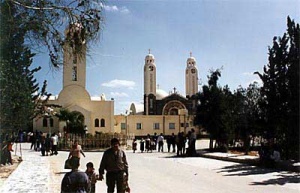Difference between revisions of "St. Mina Monastery (Mariut, Egypt)"
m (rm cat; not that this isn't a pilgrimage site, but that that category is for places that don't fit into other categories) |
m (added {{oriental}}, cat) |
||
| Line 1: | Line 1: | ||
| + | {{oriental}} | ||
[[Image:Stminamonas1.jpg|thumb|Today, thousands of pilgrims continue to flock from all over the world to receive spiritual and physical healing at the revived monastery, which has once again become "Lourdes of the East".]] | [[Image:Stminamonas1.jpg|thumb|Today, thousands of pilgrims continue to flock from all over the world to receive spiritual and physical healing at the revived monastery, which has once again become "Lourdes of the East".]] | ||
The late [[Cyril VI (Atta) of Alexandria|Pope Kyrillos VI]] established this [[Church of Alexandria (Coptic)|Coptic Orthodox]] monastery in 1959 in commemoration of [[Menas|Saint Mina (Menas)]], his [[patron saint]], in an isolated desert area very close to the archaeological site and historical city of Abu Mena in Mariut, near Alexandria, Egypt. | The late [[Cyril VI (Atta) of Alexandria|Pope Kyrillos VI]] established this [[Church of Alexandria (Coptic)|Coptic Orthodox]] monastery in 1959 in commemoration of [[Menas|Saint Mina (Menas)]], his [[patron saint]], in an isolated desert area very close to the archaeological site and historical city of Abu Mena in Mariut, near Alexandria, Egypt. | ||
| Line 10: | Line 11: | ||
[[Category:Monasteries]] | [[Category:Monasteries]] | ||
| + | [[Category:Oriental Orthodox]] | ||
Revision as of 04:53, November 28, 2005
| Note: This article or section represents an Oriental Orthodox (Non-Chalcedonian) perspective, which may differ from an Eastern Orthodox (Chalcedonian) understanding. |
The late Pope Kyrillos VI established this Coptic Orthodox monastery in 1959 in commemoration of Saint Mina (Menas), his patron saint, in an isolated desert area very close to the archaeological site and historical city of Abu Mena in Mariut, near Alexandria, Egypt.
Abu Mena is a UNESCO World Heritage Site, and was once an important Christian pilgrimage site during the 4th to 7th cent. A.D. Numerous little clay bottles (ampullae), on which Saint Mina's name and picture are engraved, were discovered by archeologists in diverse countries around the world, such as Heidelberg, Germany; Milan, Italy; Dalmatia, Croatia; Marseille, France; Dengla, Sudan; and Jerusalem. These pottery ampullae (small holy water and oil flasks brought from pilgrimage places as a souvenir, and mass-produced in Early Byzantine times) come from Abu Mena, near Alexandria in Egypt.
Countless miracles have happened and continue to happen until this day there through the intercessions of Saint Mina the Martyr, Pope Kyrillos VI and the late Abba Mina Ava-Mina (late abbot of the new monastery), whose relics (all three) are preserved in the monastery.
External Link
Categories > Church History
Categories > Church History > Canon Law > Ecclesiology > Jurisdictions > Oriental Orthodox
Categories > Church History > Canon Law > Ecclesiology > Jurisdictions > Oriental Orthodox > Coptic Monasteries
Categories > Places > Monasteries
Categories > Places > Monasteries
Categories > Places > Orthodoxy by country > Orthodoxy in Africa
Categories > Spirituality > Asceticism
Categories > Spirituality > Asceticism
